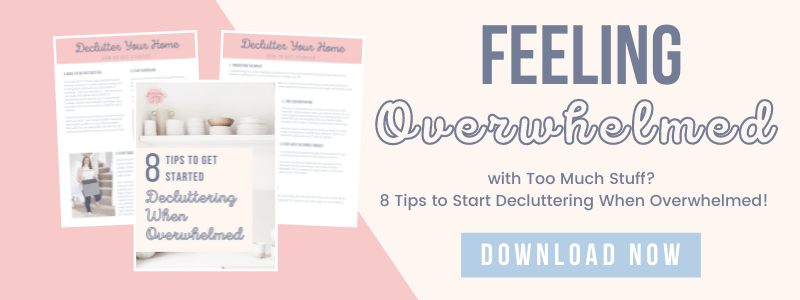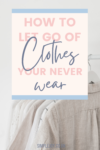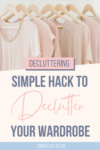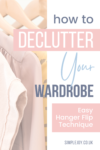Declutter Your Clothes – Mastering the Hanger Flip Method
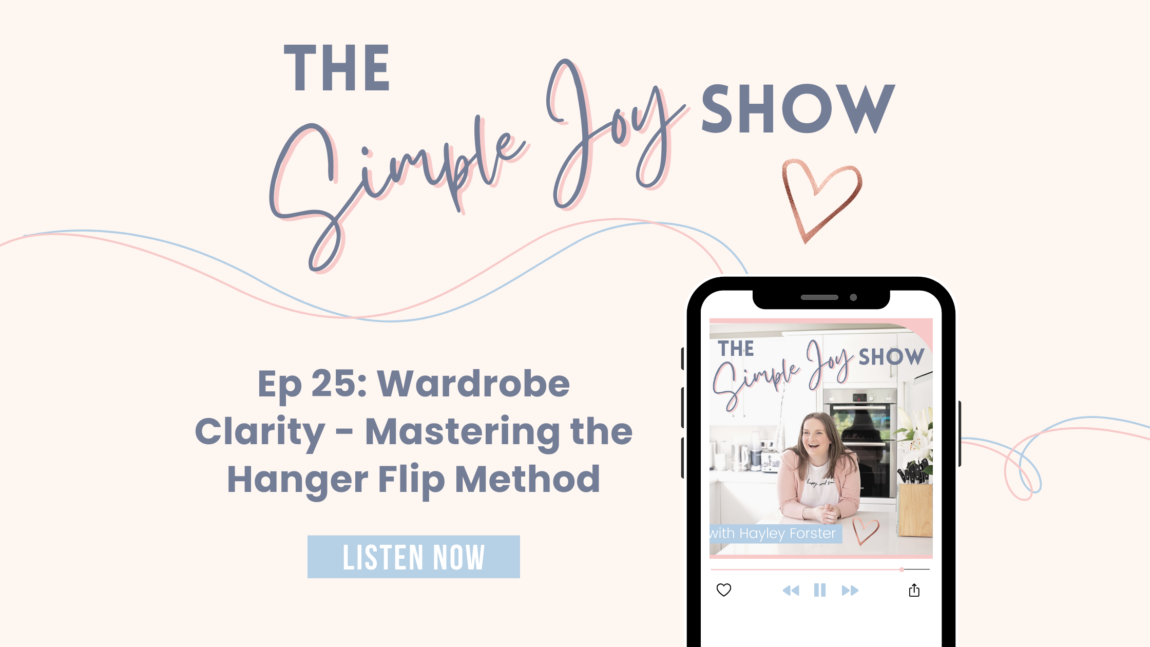
Join me in this episode of The Simple Joy Show, where I dive into how to declutter your clothes by using the Wardrobe Hanger Method – a practical and effortless approach to decluttering your wardrobe.
Discover how simply flipping your hangers can reveal the truth about your clothing habits and preferences, helping you make informed decisions about what to keep and what to let go – making it much easier to declutter your clothes!
Ideal for those seeking a low-pressure way to streamline their wardrobe and gain insight into their personal style, this episode is a must-listen if you are looking to declutter your clothes, reduce wardrobe overwhelm and achieve closet clarity.
This is the last episode of The Simple Joy Show Season One – see you in the Spring!
USEFUL LINKS:
Join the 30 Day Decluttering Challenge: https://hub.simplejoy.co.uk/challenge
Website: www.simplejoy.co.uk
How to Get Started Decluttering When Overwhelmed PDF: https://hub.simplejoy.co.uk/overwhelmed
Instagram: www.instagram.com/hellosimplejoy
Facebook Group: The Simple Living Society: www.facebook.com/groups/thesimplelivingsociety
DECLUTTER YOUR CLOTHES AND GET Wardrobe Clarity Transcript
Introduction
Hayley Forster [00:00:00]:
Hello everyone, and welcome to the Simple Joy Show. Today, we’re focusing on a favorite topic for many, and that’s our wardrobes. I am going to introduce you to the wardrobe hanger method, which is a straightforward way to declutter your clothes. It’s perfect for those who feel overwhelmed by the thought of sorting through their clothes. This method is all about simplicity and gradual decision making.
Understanding the Wardrobe Hanger Method
Hayley Forster [00:02:52]:
Let’s talk about what the wardrobe hanger method is. The wardrobe hanger method involves turning all of your hangers so they face backwards. Then every time you wear something, you hang it back with the hanger facing the right way. Over several months, you will be able to identify which items you frequently wear from your wardrobe and which ones you don’t.
Oprah brought a lot of attention to this method. It’s a really effective way to figure out what clothing you actually use. There’s that saying, we wear 10% of our wardrobe, 90% of the time. I can’t remember what the exact numbers are, but it’s probably true if you’re honest with yourself. With this method, you can track exactly what’s being used a few pieces at a time.
Benefits of the Wardrobe Hanger Method
Hayley Forster [00:03:53]:
And you know I’m going to pop into the pros and the cons. The 1st pro is that it really creates a clear visual representation of your clothing habits. So you’re going to easily see which items are your favourite and which are neglected. Now you might feel as though that’s quite obvious to you. So if you want to have a little purge before you start this project, then go right ahead.
Go through your wardrobe and see if there’s any obvious items that you can get rid of. Then focus on the “not so sure” ones for this project. It’s really gonna help you visually see how much of your wardrobe you actually use. And it’s also great for gradual decision making. For those of you who dread the idea of a full wardrobe clean out, this method allows you to make decisions at your own pace. You’re just going through your normal daily routines, and you’re naturally wearing and choosing your clothes. Then actually at the end of it, you’ve done the decluttering without even realising!
Flexibility and Adaptability
Hayley Forster [00:05:01]:
It’s a really flexible method, so it can be applied at any time of the year. You can also adapt it to suit various clothing types. So not just your everyday wear, but you might pick out your seasonal items and your special occasion items. You could say, “okay, I’m gonna do a winter wardrobe clear out.” That means you’re gonna really focus on your winter items and see how much you use. Then when you come to the end of the winter period, look to see which ones of those you’ve not used. And then you could do the same again for the warmer months. So instead of doing one big clear out, you can focus on the different types of clothes at the right time of the year.
Ease of Implementation
Hayley Forster [00:05:42]:
It is a really easy decluttering method to implement and it takes no time to get started as well. It’s literally just a case of going into your wardrobe and making sure your hangers are all facing the right way. And you could, if you wanted to, apply the same method to things outside of your wardrobe perhaps. So things like belts, jewellery, underwear, pyjamas, things that you might not keep hanging up.
You’ll need to come up with a way to mark what items are used. Obviously, the hanging ones, you’ve got the hanger method, which is switching it around. Whereas you’ll just have to work out how you’re gonna do that with the other pieces. Maybe you have them in some kind of organizing container. Then once that’s been taken out, you’ve known the you’ve worn them. Then anything that’s left in that organizing container, you know you’ve not used, for example. But that’s something that you can you can work on and decide over time.
Reducing Wardrobe Overwhelm
And then I think for me, the most important pro is that it really reduces wardrobe overwhelm. By highlighting your most worn items, it’s gonna really help you to curate a more functional wardrobe that really reflects your actual lifestyle and your preferences. Not the lifestyle that you think you should have or you would like to have or the style that you might have had a few years ago.
Hayley Forster [00:07:08]:
It’s about your current actual lifestyle, what you wear day to day. It’s gonna become a wardrobe that you can actually make the most of. And you’re able to find things so much easier. Your mornings will become so much calmer because you can go to your wardrobe as you don’t have to hunt around for what you’re looking for. And that just results in a really calm morning for you with much less stress. Now as always, there are drawbacks. So the first one is the time factor.
Drawbacks of the Method
Time Factor
This method isn’t a quick fix. It works best over a few months because that’s gonna accurately reflect your clothing choices in different situations and seasons.
Hayley Forster [00:08:00]:
When you take into consideration the different seasons throughout the year, it might even take you up to a year to fully finish this project. So if you’re wanting a quick fix for your wardrobe, this definitely is not that. If you’re into that, perhaps maybe just having what I call a “wardrobe party”. Where you just empty everything out of your wardrobe, you grab yourself a bottle of wine, put some music on and you just pretend you’re going on a date night with your wardrobe and just try everything on. Try different outfits, see if they still fit you.
If they don’t, do they make you feel good? Is it a style you don’t like anymore? And just spend a few hours in there getting it sorted, and if that’s doable for you, then go for it. If you don’t mind spending a few hours and diving into it, then that’s great. But if not and you want to do something that has minimal interruption to your day, then this hanger method is great.
Ineffectiveness for Rarely Worn Items
Another con is that the method might not be effective for items that you very rarely wear. Like really heavy winter coats perhaps or special occasion dresses that you wear once in a blue moon, weddings, and things.
Hayley Forster [00:09:15]:
But I think that can be easily rectified, as I say, by maybe doing some small and mini seasonal versions of this to make sure that you capture those in. Perhaps not the the special occasion outfits because you can’t necessarily predict when those are going to happen. So you may need to do those separate to this actual project.
Emotional Attachment
Another pro is that it doesn’t really address the emotional aspect of why we keep certain clothes that we don’t really wear often.
I always find that the wardrobe is a very difficult place for many people to declutter, and I usually recommend that you do it a little bit later on in the decluttering process for that reason. There’s a lot of things in there. There’s a lot aspirational items, perhaps clothes that you’ve bought that didn’t fit you and you thought, do you know what? I’m gonna keep these because because I’m gonna lose weight or I’m gonna gain weight, and they’re gonna be able to fit me in 6 months time. Or it might be clothing that you’ve worn on special occasions. Perhaps it was a dress and you got proposed to in, or it was an outfit that you wore when you found out you got your favourite job, something like that.
Memories and Emotions
Hayley Forster [00:10:32]:
But there’s a lot of memories and emotions attached to clothes. And this method doesn’t naturally address those. It’s much more transactional. It’s about the clothes you’re wearing and the clothes that you’re not wearing. But then what the intention is is that then you can just take all the ones that you’re not wearing and take them to the charity shop or to donate them elsewhere. But that’s not necessarily the case because you can look at those and you can go, right, well, I’m not wearing these, but then you might find yourself actually going, but I want to keep this because of x, y, and z, or I want to keep that one because of this. And you end up then keeping 50%, perhaps, of what you were intending to get rid of.
METHOD Watch Outs
Hayley Forster [00:11:15]:
So this method doesn’t address that side of it. I think it’s definitely an add on that you need to think about at the end. It definitely pulls out the things that you don’t wear. But you still then have to consider the processing of those at the end of the project. And one last watch out I would say is just try to make sure that you do put the clothing back on the hanger facing the right way depending on if you’ve worn it or not. Because I’ve known a few people that have done this exercise, and actually, they just completely forgot about the hangers, and they were just putting things in willy nilly. And then it got to, like, 2 or 3 weeks down the line.
They’re like, well, actually, I need to start again because I’ve not done this right, and then it just ends up being a bit of waste of time. So just try and keep on top of keeping the hangers the right way, and it should go right for you in the long run.
Ideal Candidates for the Wardrobe Hanger Method
Hayley Forster [00:12:08]:
But who are the ideal candidates for this wardrobe hanger method? I would say that this method is particularly great for those of you who prefer decluttering decisions based on actual usage, rather than the emotional attachment. If all you wanna know is what you’re wearing and what you’re not then this is perfect for you. It’s also ideal for anyone that’s looking to gradually work towards a minimalist wardrobe. And for those of you who perhaps need a bit of a clearer idea of their dressing habits as well. You can then take your time over it.
You can be really intentional with it and, ultimately, 6-9 months down the line, end up with a really well fitting wardrobe that makes you feel you and makes you feel great.
Conclusion and Final Thoughts
And, ultimately, I think the wardrobe hanger method is more than just a decluttering technique. Actually, it’s a real big journey towards understanding you, your personal style, and your needs, and that can really help moving forward with your intentional purchases as well. Which is a massive additional bonus. So if you’ve tried the wardrobe hanger method or you’re planning to give it a go, I’d love to hear about your experience.
Hayley Forster [00:13:25]:
Just connect with me using the #simplejoyshow or come into my Facebook group, The Simple Living Society, and share your wardrobe decluttering stories, good or bad.
Closing Remarks
And before we wrap up, I just want to say that we’ve reached the final episode of season 1. It has been an incredible journey, and it’s filled with what I hope has been practical and inspirational tips to help you embrace a simpler, more intentional life. As we wrap up the season, I want to take a moment to express my heartfelt gratitude for your support and for your engagement.
It’s been an absolute joy to share my episodes and learn alongside each of you that has been listening. And as we all know, part of living simply is really knowing when to take a step back and recharge. So in that spirit, The Simple Joy Show is gonna be taking a short break. But fear not, I’m gonna be back for season 2 in the spring. But this break is really gonna give me the perfect opportunity to come up with some new ideas. Get some fresh insights from my clients, and come back with even more content that’s gonna inspire and motivate you on your journey towards simplicity.
Hayley Forster [00:14:45]:
So until then, keep embracing the small joys and the big changes. And remember, the path to a simpler life is always there waiting for us to take the next step. Stay tuned for our return in the spring. Keep an eye on my socials for the actual launch date. So if you follow me on Instagram, it’s @hellosimplejoy. But in the meantime, continue to share your stories, your insights, and experiences in my Facebook group. Or with the simplejoyshow community hashtag on Instagram. Thank you for a fantastic 1st season, and I look forward to reconnecting with you all soon. Stay simple. Stay joyful.
Not sure how to get started decluttering?
Get your free 8 Tips to Get Started Decluttering When Overwhelmed PDF!
I am going to help you move forward knowing how to get the motivation to get started on your decluttering journey and most importantly keep going. Follow these tips and watch your home become clutter free!
